Stay in the know on all smart updates of your favorite topics.
Sustainable energy is the future. The city of Amsterdam has the ambition to provide every citizen with a solar panel in the next years. How do you contribute? Share your innovative initiatives on energy here.
‘De eco-mode bespaart nog zeven procent energie extra’
De coronacrisis heeft de transitie naar de digitale economie versneld: we werken thuis, bestellen onze boodschappen online en netflixen meer. Dat zorgt ervoor dat er meer data wordt gegenereerd, verstuurd en opgeslagen en dit vraag meer energie. De eerste pilots van ons initiatief LEAP laten zien dat partijen extra energie kunnen besparen door de bestaande eco-mode op hun dataserver beter in te zetten.
Eén van de pilots draaide op het interne datacenter van KPN. Is het echt mogelijk om met meer ambitieuze settings extra energie te besparen zonder in te leveren op de snelheid van de server? Vier medewerkers van KPN vertellen hoe het is verlopen.
Lees verder:
https://amsterdameconomicboard.com/nieuws/eco-mode-bespaart-extra-energie
Deadline for business ideas ClimateLaunchpad postponed till May 17th
ClimateLaunchpad @ AMS Institute is a program aimed to fast-track promising innovative ideas to the next level, by providing knowledge, connections and experience you need to go for that next step. We're looking for young and eager entrepreneurs who want to tackle climate change and make our cities more sustainable.
ClimateLaunchpad @ AMS Institute postpones application deadline till May 17th. And goes digital due to COVID-19 outbreak. Read all about it on our post!
Amsterdam launches next stage of circular economy programme
Amsterdam will launch the fourth stage of its circular economy initiative next week, with 200 new projects planned for the coming year. Its 2020-2025 strategy, set to be published 8 April, will build on last year’s programme that saw 116 projects implemented.
RVO announces European Green Deal call for SMEs
The European Green Deal is the European Commission's strategy for a more sustainable, cleaner and healthier European economy. Research and innovation are of course key to make this happen. RVO (the Dutch agency for subsidies) announces several calls in the coming months of 2020 with a total budget of € 1 billion.
First one on the planning is a special EIC accelerator call for SMEs that need some help to develop a green idea and scale it up internationally. Support will be a subsidy up to € 2,5 million and there is an option for receiving equity up to € 15 million. Projects need to contribute substantially to the European goals for fighting climate change.
Please note that this information is preliminary, more info in Dutch on the website of RVO and we expect that the EU will publish this call in the coming weeks. The RVO-site will update the links to the EC call info, which is not online yet.
Learn more about the smart city with these videos! Edition 2: Energy in the City
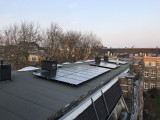
While most of us are working from home in these surreal times, the Amsterdam Smart City team will support you with some inspiration and learnings about the city. We handpicked videos worth watching!
Your agenda might still be full with Zoom videocalls or maybe your helping your neighbours with some groceries. Either way, hopefully these videos will be an inspiration and give you some welcoming new insights. Time to check out videos about the development of the city!
We selected these ones about Energy in the City: recorded in 2019 in Pakhuis De Zwijger, thé dialogue center in Amsterdam. Enjoy!
4 september 2019: AMS Science for the City #6: Energy & Spatial Changes (in English)
The transition towards a low-carbon future is accelerating across all sectors in The Netherlands. But are we doing enough, and are we pursuing the right strategies? How much space does the energy transition require and are we able to accommodate those needs in our densely populated country? What is the spatial impact of this transition on the living environment, in both urban and rural landscapes? The AMS Institute dives into the dynamics and solutions of the sustainable energy transition; and explores its spatial, social and technological questions for the city of Amsterdam, its metropolitan region and the Netherlands as a whole.
[►
AMS Science for the City #6: Energy & Spatial Changes
The transition towards a low-carbon future is accelerating across all sectors in The Netherlands. But are we doing enough, and are we pursuing the right strategies? How much space does the energy transition require and are we able to accommodate those needs in our densely populated country? What is](https://www.youtube.com/watch?v=E24-xb1YNYE)
16 oktober 2019: Amsterdam Smart City – Het Net onder Spanning (in Dutch)
De veranderingen op het gebied van duurzaamheid zijn in volle gang. Elektrische auto’s, warmtepompen en zonnepanelen zorgen ervoor dat we steeds dichterbij en zelfs in huis ons steentje bij kunnen dragen. Deze vernieuwingen doen tegelijkertijd een groot beroep op het elektriciteitsnet in de stad. Om de toenemende vraag naar stroom te kunnen blijven leveren, is meer infrastructuur nodig. Maar ook anders omgaan met ons verbruik en keuzes maken zijn noodzakelijk. Hoe doen we dit? Wat is nodig om vooruit te blijven gaan? En hoe betrekken we bewoners hierbij? Samen met partners van Amsterdam Smart City zoals overheid, bedrijven en bewoners, gaan wij hierover in gesprek. De eerste 10 minuten van de opname missen.
[►
Amsterdam Smart City #5: Het net onder spanning
De eerste 10 minuten van de opname missen, excuses voor het ongemak. De veranderingen op het gebied van duurzaamheid zijn in volle gang. Elektrische auto’s, warmtepompen en zonnepanelen zorgen ervoor dat we steeds dichterbij en zelfs in huis ons steentje bij kunnen dragen. Deze vernieuwingen doen](https://www.youtube.com/watch?v=WZfNqzWDfj8)
18 november 2019: Urban Books #66: Energietransitie als gebiedsontwikkeling (in Dutch)
Hoe kan Nederland een wereldlaboratorium worden voor effectief, duurzaam en participatief realiseren van integrale en complexe opgaven binnen de energietransitie? Met zijn boek ‘Energietransitie als gebiedsontwikkeling’ laat bestuurskundige Peter van Rooy zien hoe Nederland weer tot de top van de wereld kan behoren als het gaat om integrale gebiedsontwikkeling, startend vanuit de energietransitie.
[►
Urban Books #66: Energietransitie als gebiedsontwikkeling
Hoe worden we wereldwijde koplopers van de energietransitie binnen gebiedsontwikkeling? Boekpresentatie Peter van Rooy. De energietransitie is een complexe opgave. Door het toevoegen van windmolens, zonnepanelen, nieuwe infrastructuur, zowel boven- en ondergronds, dreigt ons hooggewaardeerde landsc](https://www.youtube.com/watch?v=lPozVt2jmwg)
23 oktober 2019: Waterstof: dé duurzame energiedrager of niet? (in Dutch)
Volgens de provincie Noord Holland, de stad Amsterdam, de haven en de netwerkbedrijven is waterstof essentieel voor de energietransitie van de regio. Waterstofgas kan een alternatief zijn voor aardgas voor verwarming, zorgen voor verlichting van het overbelaste elektriciteitsnetwerk en of dienen als brandstof voor auto’s; de plannen vliegen je om de oren. Maar hoe realistisch zijn deze plannen en alternatieven? Zijn ze wel écht duurzaam? En waarom hebben we het ineens over 'blauwe waterstof'? In dit programma houden we drie mogelijke toepassingen in de regio – voor de industrie, gebiedsontwikkeling en mobiliteit – kritisch tegen het licht.
[►
De Energietransitie #29: Waterstof: dé duurzame energiedrager of niet?
Volgens de provincie Noord Holland, de stad Amsterdam, de haven en de netwerkbedrijven is waterstof essentieel voor de energietransitie van de regio. Waterstofgas kan een alternatief zijn voor aardgas voor verwarming, zorgen voor verlichting van het overbelaste elektriciteitsnetwerk en of dienen als](https://www.youtube.com/watch?v=1dKEqLtEUlI)
We will add more videos in the next days and collect all of them here. Check out videos about Energy, Circular City, Mobility and Citizens&Living.
The Amsterdam Smart City team loves new insights as well. So, we’re curious… What videos do we have to see? And what articles do we have to read? Share your input in the comments!
Routekaart Amsterdam Klimaatneutraal 2050

Op 6 maart was de feestelijke lancering van de Routekaart Amsterdam Klimaatneutraal in 2050. En ik was hierbij aanwezig! Met de Routekaart laat de gemeente zien hoe zij op weg is naar een Nieuw Amsterdams Klimaat.
Op 6 maart was de feestelijke lancering van de Routekaart Amsterdam Klimaatneutraal in 2050. En ik was hierbij aanwezig! Met de Routekaart laat de gemeente zien hoe zij op weg is naar een Nieuw Amsterdams Klimaat. Het is een ambitiedocument met een lange termijn visie op de Amsterdamse energietransitie en acties voor de korte termijn. De gemeente gaat samen met bewoners, bedrijven en instellingen intensief samenwerken om de verandering naar duurzame energie in beweging te zetten. Hier kijk ik met veel enthousiasme en bewondering naar. Voor mij is het open en transparant delen van kennis hét sleutelwoord in de transitie. Met elkaar leren door te doen, aan de slag te gaan. Zo gaan we samen op weg naar betere straten, buurten en steden voor iedereen!

De Routekaart is inhoudelijk opgedeeld langs 4 transitiepaden: gebouwde omgeving, verkeer & vervoer, elektriciteit en haven & industrie. Enerzijds neemt de gemeente Amsterdam top-down initiatief en werkt planmatig aan het behalen van doelen. Anderzijds is de basis van duizenden kleinere initiatieven net zo hard nodig: via een bottom-up benadering. Amsterdammers die zelf aan de slag willen, bewoners, bedrijven en instellingen, alleen of samen, kunnen op steun rekenen.
Gebouwde Omgeving
In 2050 moeten alle gebouwen in de stad op een duurzame manier worden verwarmd. Vervanging van aardgas door alternatieve warmtebronnen én energiebesparing staan daarom centraal. Dit betekent dat er achter elke voordeur, achter elke gevel en in iedere straat iets staat te gebeuren. De pijlers zijn:
- Opschalen van de wijk-voor-wijk aanpak aardgasvrij
- Ontwikkelen van duurzame bronnen voor het warmtenet
- Doorgroeien naar een stadsbrede warmte-infrastructuur
- Energiezuinig maken van woningen
- Energiezuinig maken van zakelijke markt
- Energiezuinig maken van maatschappelijke gebouwen
- Energieneutraal bouwen
Verkeer & Vervoer
In 2030 is al het verkeer op de Amsterdamse wegen en over het water uitstootvrij. Er is ruimte in de stad voor voetgangers, fietsers en spelende kinderen en er zijn minder autoritten. De pijlers binnen transitiepad Mobiliteit zijn:
- Beperken vervuilende verkeerbewegingen
- Verschonen van alle vervuilende voer- en vaartuigen
Elektriciteit
In 2030 is 80% van de elektriciteit die huishoudens gebruiken opgewekt uit zonne- en windenergie. Elektriciteit speelt een sleutelrol in de energietransitie. Door de overgang naar een aardgasvrije stad en de groei van het aantal elektrische voertuigen is er veel meer elektriciteit nodig. De pijlers zijn:
- Maximaal opwekken van zonne-energie op daken
- Optimaal benutten potentie windenergie
- Werken aan een toekomstbestendige elektriciteitsinfrastructuur
Haven & Industrie
In 2050 is de industrie volledig overgestapt op duurzame energiebronnen. In 2030 behoort de haven van Amsterdam tot de duurzaamste havens van Europa en zijn steenkolen volledig uit te faseren. Daarnaast zal de haven fungeren als duurzame batterij voor de stad, regio en Europa. De pijlers zijn:
- Transformeren van de haven naar duurzame batterij
- Ontwikkelen groene waterstofeconomie
- CO2-uitstoot afvangen, opslaan en hergebruiken
- Energie besparen in de industrie
Voor de transitie van fossiele naar duurzame energie moeten we ons niet alleen richten op CO2. Randvoorwaarden zoals draagvlak en samenwerking zijn net zo belangrijk. De vraagstukken zijn groot en vaak met elkaar verweven. Wij, bij Amsterdam Smart City, geloven dat innoveren op deze grote vraagstukken samen moet. Binnen Amsterdam Smart City brengen we deze partijen dan ook samen. Als onafhankelijk platform, ieder vanuit zijn eigen rol. Vanuit gedeelde waarden en doelen. Ik werk met veel plezier, samen met onze partners, aan het verwezenlijken van deze mooie plannen voor de stad!
Verder lezen over de Routekaart Amsterdam Klimaatneutraal 2050? Neem een kijkje op de website van de gemeente: <https://www.amsterdam.nl/bestuur-organisatie/volg-beleid/ambities/gezonde-duurzame-stad/klimaatneutraal/#hc2e477b3-ad38-4b31-94ce-27b325c542e7>
Gebruik je portemonnee voor de energietransitie: wat je privé en zakelijk kunt doen qua groene keuzes
Protesteren tegen de bio-industrie, maar wel een lekkere gegrilde plofkip op de markt kopen. De lege winkelstraat ongezellig vinden, maar wel online shoppen en alles thuis laten bezorgen. Tja, dat helpt natuurlijk niet. En het lijkt ook alsof het maar een druppel op de gloeiende plaat is, als jij in je eentje een betere keuze maakt. Toch kun je als consument of met je organisatie wel degelijk impact maken.
In dit artikel een overzicht van welke keuzes voor jou als consument, én voor de organisatie waar je werkt, positief kunnen bijdragen aan de energietransitie.
New Operating System For Smart Cities The philosophy behind the system is what makes the difference.
My article on the operating system for cities was published in the prestigious Dubai Smart City Network #neos #smartcities #SmartCitiesPolska
If the operating system performs its function in the background, we can experience games and multimedia on the screen and use our software necessary for a business. The same rule applies to cities and it’s “operating system”.
Wat betekenen Livings Labs voor de Metropool Amsterdam?
In februari geven we met Board Insights een podium aan diverse Living Labs binnen de regio.
In deel 1 spreken we met Chandar van der Zande, die nauw betrokken was bij De Ceuvel. Één van de meest duurzame en vernieuwende experimenten in Europa.
“De Ceuvel 2.0 was het meest innovatieve stukje van Amsterdam, 3.0 moet dat ook weer worden. Alleen dan groter en beter. En dat is hard nodig want we hebben nog maar tien jaar om de oplossingen voor een nieuwe economie te bedenken, te toetsen en op te schalen om de klimaatcrisis het hoofd te bieden.”
Coalitie datacenterketen wil 40% energie besparen
Initiatief ‘Lower Energy Acceleration Programme’ moet energie-efficiëntie van ICT in datacenters optimaliseren en ruimte creëren voor toekomstbestendige en duurzame groei
Een coalitie van bedrijven uit de Amsterdamse datacenterketen gaat samen met overheden aan de slag in het datacenter-energiebesparingsinitiatief ‘LEAP’. Verwachting is dat het energieverbruik in datacenters hiermee tot 40 procent kan worden teruggebracht in de komende drie jaar. Met het initiatief trekken overheid, bedrijven en kennisinstellingen samen op om in een hoger tempo een duurzame digitale economie te realiseren. Gedurende de eerste fase gaan 20 coalitiepartners in pilots onderzoeken wat de mogelijkheden voor energiebesparing zijn, zonder prestatieverlies.
Op weg naar een flexibel, robuust en betaalbaar energiesysteem
In mei van dit jaar trad Ingrid Thijssen, CEO van Alliander, toe tot de Board. Als één van de grootste energienetwerkbedrijven van Nederland, voelt Alliander een grote maatschappelijke verantwoordelijkheid. Daaraan geeft het bedrijf onder meer invulling door actief bij te dragen aan de ambities van de Board. “Door slim samen te werken, vooruit te kijken en slim gebruik te maken van de openbare ruimte, maken we de regio samen klaar voor de toekomst.”
The Future of Urban Energy
It's unlikely that our current energy system will be able to continue to guarantee reliability in the future as different factors cause a massive impact on our energy supply.
Although electricity use in Amsterdam is relatively stable today, this will change in the near future. Due to expected population growth, increasing use of electric vehicles and the shift from gas boilers to electric heat pumps, we will start consuming more and more electricity.
On the other hand, and at the same time, the supply of solar and wind energy is growing rapidly. This sustainable energy will replace non-renewable energy increasingly into the system. Unfortunately, this is not without complications.
With all these changes ahead: how can we transition to a reliable, affordable and sustainable energy system? In the below long-read we explain how we work on the future of urban energy.
Smart heat pump options are heavily underutilized

In 2018, only 25% of heat pumps on Dutch market are connected to the internet, and virtually no heat pump is ready for flexible control, according to research conducted by Delta-ee on behalf of FAN.
Read the news item (in Dutch) on the FAN website:
https://lnkd.in/dEdwQgZ
Download the report, in English:
https://lnkd.in/dJJi8eH
#smartenergy #heatpump #flexibleenergy
‘Urgency creates opportunities’ – recap of the Amsterdam Smart City event ‘Het Net Onder Spanning’
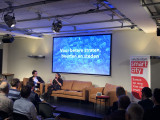
The changes in the field of sustainability are in full swing. Electric cars, heat pumps and solar panels ensure that a lot of people can make their contribution, even at home. At the same time, these innovations appeal to the electricity grid in the city. More infrastructure is needed to be able to supply the increasing demand for electricity. On the other hand, we have to deal with electricity in different ways. How do we do this? What is needed to keep moving forward? And how do we involve residents in this?
On the 15th of October, Amsterdam Smart City and some of our partners discussed this topic in Pakhuis de Zwijger. Amsterdam Smart City aims for a conversation between its partners and the general public. After all, residents are the ones that have to deal with all innovative projects and the ones with great initiatives themselves, so let’s involve them as soon as possible!
This summer, grid operator Liander and the City of Amsterdam launched a report with an alarming message: in 2050 we will need 2,5 times more electricity than we do now. Eric Koldenhof from the Sustainability department of the City of Amsterdam and Paul van Engelen, region lead Amsterdam of Liander told the audience that this is quite a puzzle, with a growing population and shrinking physical space. For Amsterdam this expected increase in electricity demand means we will need 6 to 8 more electrical substations and around 2.500 small containers throughout the city. They showed a map with warning signs: some of the current substations are already reaching their maximum capacity.

Leonie van den Beuken, program director of Amsterdam Smart City, asked Koldenhof and Van Engelen how critical this issue really is: ‘Is there a possibility we will not be able to switch on a light in the near future?’ Paul: ‘We won’t lose power, don’t worry. The real problems are the new developments. With the current capacity on the grid, it will be very hard to connect new customers, such as big car charging stations or datacenters.’
We will need to expand the electricity grid, but there are two other big recommendations in the research: we need innovative solutions that can work off the grid or efficiently to reduce the impact on the grid and the City and Liander want to look forward and cooperate more. If we have to open up a street for cabling, this can be a possibility to do other constructions simultaneously.
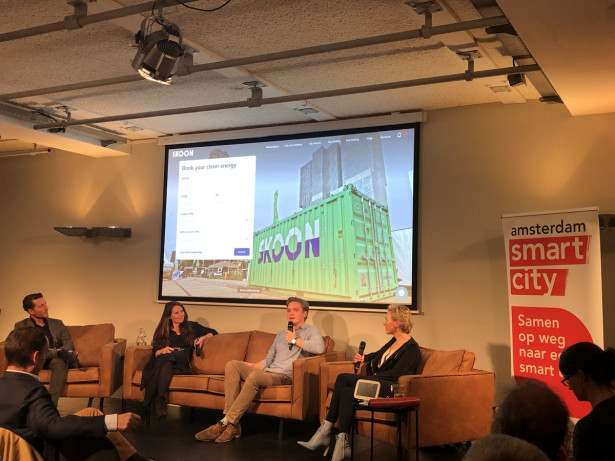
Falco Pieters from Stichting Wiek-II, Peter Paul van Voorst from Skoon Energy and Marjolein Bot from the Amsterdam Economic Board are the ones with solutions to unburden the electricity grid. In Arnhem-Nijmegen, Falco combines technological innovations, wind and solar energy with the participation of citizens. Wiek-II found a way to connect this generated energy to the grid more efficiently and they are happy to copy the concept to other areas in the Netherlands.
Skoon Energy created big switch batteries, mainly for the maritime sector, but they also work for festivals and construction – and perhaps even in the city as a temporarily solution These batteries are short term solutions, but batteries can be charged when there is space on the grid. Peter Paul: ‘I am really happy with the ambitions of the City of Amsterdam and the urgency for innovation. This creates opportunities for my business!’
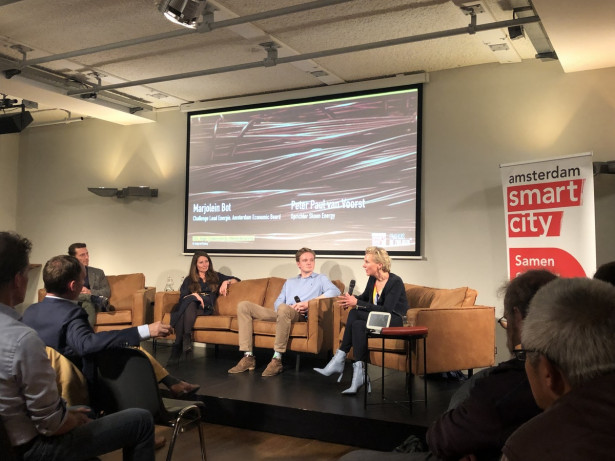
Marjolein Bot told the audience about her research on the influence of digitalization. Not only sustainable solutions ask for more electricity, data and digitalization are increasing the demand as well. Marjolein is working on efficiency in IT such as green coding, photonics, blockchain, AI and datacenters.
In 2021 governments with plans for the public space will be obliged to incorporate citizens’ opinions in their plans (‘Omgevingswet’). This means that participation and co-creation with citizens is becoming more important, also in the decision on where to build new electrical substations in the city. How can we make sure that participation is useful and meaningful? Dave van Loon (Kennisland), Melika Levelt (Amsterdam University of Applied Sciences) and Pauline Westendorp (02025) are working on participation on a day-to-day basis.
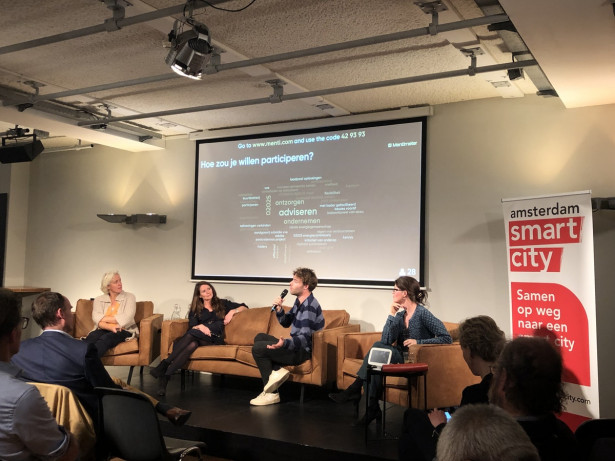
The panel discussed the conditions for citizens to participate in these kind of processes. Melika Levelt: ‘As a government or company, please be clear about the processes that are fixed and that are going to happen anyway. Be clear about the influence residents can have and tell them honestly if you have to make another choice because of political reasons. Citizens will only be interested if you have clear and concrete questions. Take time to hear as many opinions as possible. They really have a feeling about the physical space and their neighbourhood, so take this into account. It is not only a project, but really a place to live.’ Dave: ‘And it is very important to realize that a lot of individuals won’t take the time to cooperate with you. You have to get in touch with citizens’ initiatives and local cooperatives.’

Paulien challenged the City of Amsterdam: ‘Can we focus on developments before 2030 or 2050? Can we make changes now or tomorrow? People are ready for it!’ But be aware: not everyone wants to participate. Some people just want others to take the lead in these developments. And that’s fine as well.
Watch the live feed of the evening here: <https://dezwijger.nl/programma/het-net-onder-spanning>
Want to know more about this? Visit the Kennisland event ‘Out of Office #29: ‘Eerlijke en inclusieve energietransitie: snel en toch samen?’ about the honest and fair energy transition. (in Dutch) Thursday 31 of October in Amsterdam!
How was the renovation? Tell us!
As part of the European subsidized City-zen project, it is important to learn about the impact of home renovations on energy saving and behavioural change. To learn from YOUR experiences with the renovations, we ask you to complete the online questionnaire. This questionnaire is part of the research that TU Delft is doing on what makes renovations a success or not. The results will only be used for City-zen reports and scientific publications.
Below you will find the link to this online City-zen questionnaire, which takes approximately 20 minutes to complete. Your cooperation is very important for future renovation projects. We hope you will also participate!
Energietransitie slaagt alleen als iedereen mee kan doen
Op naar een meer sociaal-inclusieve energietransitie in en vernieuwing van de wijk!
Het Net Onder Spanning
De veranderingen op het gebied van duurzaamheid zijn in volle gang. Elektrische auto’s, warmtepompen en zonnepanelen zorgen ervoor dat we steeds dichterbij en zelfs in huis ons steentje bij kunnen dragen. Deze vernieuwingen doen tegelijkertijd een groot beroep op het elektriciteitsnet in de stad. Om de toenemende vraag naar stroom te kunnen blijven leveren, is meer infrastructuur nodig. Maar ook innovatieve oplossingen en keuzes maken zijn noodzakelijk.
Om de uitdagingen zo goed mogelijk in kaart te brengen, is netbeheerder Liander vorig jaar samen met de gemeente Amsterdam een studie gestart naar de groeiende stads- en energietransitie.
Op 15 oktober organiseert Amsterdam Smart City over dit onderwerp een sessie in Pakhuis de Zwijger. Liander en de gemeente zullen de themastudie toelichten, er is ruimte voor innovatieve oplossingen uit ons netwerk en we bespreken met partners van Amsterdam Smart City welke belangrijke rol bewoners hebben. Kom je ook? Meld je aan! https://amsterdamsmartcity.com/events/het-net-onder-spanning
How to become a climate-neutral city
This is the third edition of my new series 'Looking for the humane city'. This article answers the question how city administrators together with other stakeholders can reduce emission of greenhouse gasses. At the same time is is a critical appraisal of current policies from a humane perspective. This is urgent as a group of citizens is at odds with environmental policies, as they feel it harms their interests.
You can find the Duch version of this article here: https://wp.me/p32hqY-1MX
Call for Expression of Interest for Pilot Living Lab at JRC Petten
Living labs are a modern way of creating user-centred environments that enable innovation, co-creation and start-up development.
We launch a call for expressions of interest to co-create living labs in two of our research sites Ispra, Italy and Petten, the Netherlands for smart city solutions.
Future mobility solutions in Ispra encompassing
ad-hoc shared rides
door-to-door automated delivery
vehicle connectivity and communication (V2X)
automated shuttle, robo-taxi
clean vehicle solutions
Digital energy solutions in Ispra and Petten encompassing
smart meters, sensors and devices to collect energy and well-being data
ICT infrastructure
Interactive user interfaces, geographic information systems, data analytics
We offer
a city-like, controlled environment
state-of-the-art laboratories and technical support
scientific expertise
advanced infrastructures
And the winners are...

On 16-17 June we organised, together with the City of Amsterdam, AMS Institute and EIT Climate-KIC, a 24-hour non-stop pressure cooker event. 45 participants worked in 8 multi-disciplinary team to ideate, uncover insights and propose innovative solutions to the city's urban challenges.
The 24-hours Amsterdam City Challenge is one of the events that Amsterdam organises to stimulate their citizens to come up with bright and bold ideas for a sustainable future. The challenges of this event where about Mobility and the Energy Transition:
Mobility
- How can we organize the supply of fresh food and beverages in the city, in a more efficient manner?
- How can we improve management of the mobility flows to major tourist attractions more effectively, such as the Zandvoort beach on sunny days?
- How can we increase the safety of cyclists with respect to congestion on the bike paths and roads (i.e. electric bikes, cargo bikes, and regular bikes)?
Energy Transition
- Taking the Haparandadam as a point of inspiration, how can we install solar power in unusual places?
- How can we make data centers greener?
And the winners are...
Amsterdam City Challenge - Innovate the City in 24-hours
Of course every challenge has its winners. But the compliments go to all the participants that where awake for over 24 hours! It is quite a challenge to stay awake... But during this pressure cooker, all kinds of great ideas come alive. That is the great thing about this 24-hours event.
The winner of the Mobility Challenge is team Extra Mile. They came with the idea to use the infrastructure of the trams to deliver food and beverage supplies to the restaurants and bars in Amsterdam. In order to realise this, this team introduced 'De Vreet Tram' ('Vreet' means 'eating a lot' in Dutch).
The winner of the Energy Transition Challenge and the Tada-price is Switchport. This team developed a great idea to combine art with the construction of solar panels. They also wanted to make the use of the solar panel inclusive for the citizens.
Besides winning € 1,000 to work on their ideas furthermore, the teams also got the opportunity to present their ideas during WeMakeThe.City
Stay up to date
Get notified about new updates, opportunities or events that match your interests.

